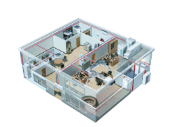Buildings are responsible for nearly half of all UK carbon dioxide emissions, with non-domestic buildings producing 18%, principally from space heating and cooling, water heating, lighting and other building systems.
Building owners and managers are increasingly seeking out climate control solutions that achieve high levels of energy efficiency while maintaining indoor comfort. Here, Daikin UK technical expert, Martin Passingham considers the benefits of designing a whole building for a balanced interior climate and a greener environment.
Buildings are responsible for nearly half of all UK carbon dioxide emissions, with non-domestic buildings producing 18%, principally from space heating and cooling, water heating, lighting and other building systems.
When designing new buildings, many organisations use BREEAM as a mandatory standard to ensure that they meet the exacting requirements for CO2 emission reductions. In addition to this, the new Part L of the Building Regulations came into force in April 2014. It requires energy efficiency standards of new non-domestic buildings to improve by 9% on the 2010 regulations. The new rules also apply when specific building services work, including climate control, is carried out.
With these rising demands for sustainable buildings, plus volatile energy prices and a warming climate, the business case for reappraising whole building energy strategies for efficiency savings is clearly growing. To meet the new requirements, building managers are increasingly looking towards HVAC systems that deliver heat into all building areas in a balanced, energy-efficient and controlled way.
Variable refrigerant volume (VRV) technology with variable refrigerant temperature (VRT) and integrated heat recovery offers one of the few whole building solutions that achieve both efficiency and zoned building user comfort at reduced energy cost and CO2 emissions. Unlike traditional HVAC solutions, which are commonly powered and operated separately from each other, an integrated 3-pipe VRV system that provides simultaneous heating and cooling makes better use of the primary energy source. Additionally, VRV with heat recovery effectively re-uses the ambient heat produced by equipment and lighting, refrigeration units, solar gain and body heat, which otherwise would be rejected and released into the atmosphere, for heating and hot water generation. Such a total climate control system supports building operators in achieving their CO2 reduction targets and lowers operating cost in the long-term, contributing to a more sustainable built environment. At the same time, the latest generation of VRV manipulates evaporating and condensing temperatures to help the system meet the required loads at all times, consistently aiding optimum balance between efficiency and tenants’ indoor comfort across varying building zones.
The ultimate operating condition for VRV systems usually occurs during autumn and spring temperatures and demands in the building may balance to 50% heating and 50% cooling. This is where VRV operates at maximum efficiency, with almost no rejected energy.
For example, a regular office building requires cooling and heating to maintain the indoor temperature between 20°- 24°C degrees, with 200 litres of water storage being required for washrooms and 150 litres of water storage for kitchens. By recovering the heat from indoor units in cooling mode, a co-efficient of performance (COP) of 4 can be achieved.
In milder conditions, when 75% of the indoor units are in cooling mode with 25% in heating mode, the efficiencies rise to COPs of 6. When a VRV system is fully balanced between heating and cooling, however, performance efficiencies can increase even further and reach in excess of 7.
The key is to design the system so that it operates as close as possible to a balanced heating and cooling operation for the maximum amount of time, according to the building’s energy usage statistics. The heat usage of new buildings is typically balanced by integrating a number of peripheral functions, including the use of waste heat from cooled areas, such as IT rooms or hotel kitchens, heating water overnight or connecting to low temperature hot water modules for underfloor heating.
To achieve higher COPs, in any case, it is vital to analyse right from the start a building’s usage patterns, varying occupancy levels and projected energy consumption. This will enable the design of an intelligent, modular system that maximises seasonal efficiency and capitalises on existing sources for heat recovery. Individual design also allows the VRV system to be scaled to fit any size of commercial building over its lifetime and to be reconfigured easily if occupant needs or internal layouts change. This adaptability gives building owners and managers the reassurance that VRV with heat recovery will suit the application long into the future with minimal disruptions to day-to-day operations when reconfiguration or upgrade of the system does become necessary.
The benefits of a total HVAC solution using VRV technology are clear. Increased energy efficiencies reduce the building’s carbon footprint and bring down energy bills, while flexible, modular design options for balancing heat and cooling in buildings across the retail, healthcare, offices, hospitality and public sectors future-proof the whole building solution to deliver indoor comfort in the long-term.